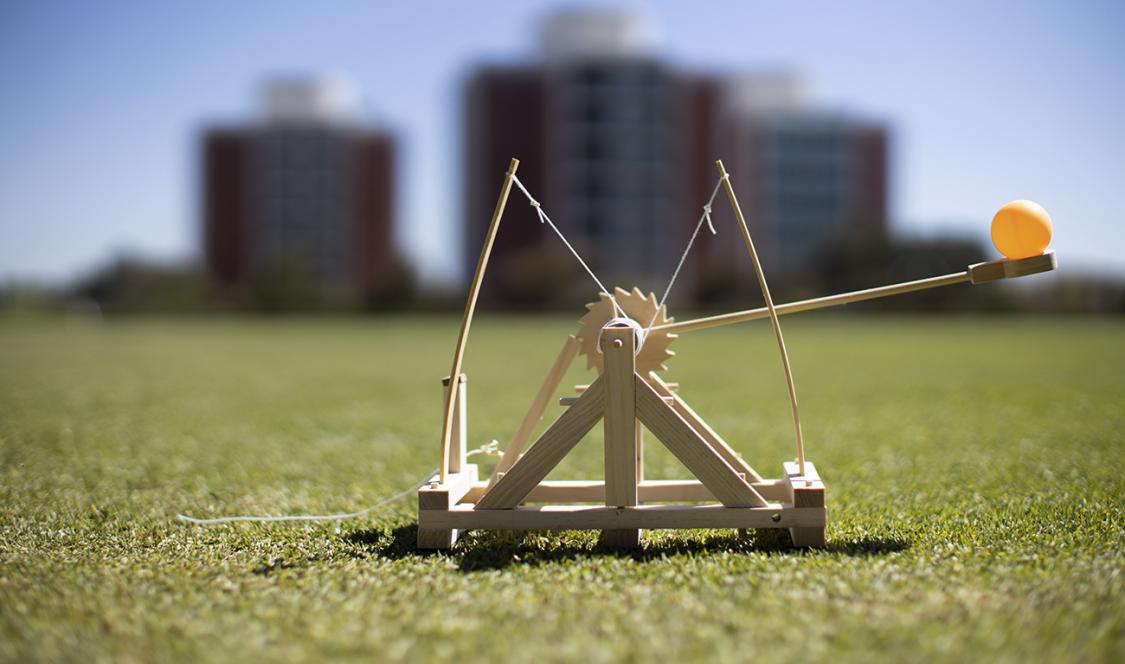Across the CMC curriculum, members of our faculty are meeting the challenge of these unprecedented and historic times, delivering exceptional coursework in a fully online modality for the fall semester. In our Academic Innovations series of faculty Q&As, professors share their curricular highlights, best practices, and how students are helping to shape virtual learning for a memorable, collaborative academic experience.
Janet Sheung, assistant professor of physics, is teaching “Principles of Physics Laboratory” this fall.
What are some ways you are reimagining your “Principles of Physics” class for the fall?

My science colleagues and I are sending a special box to each of our lab students. It doesn't get more interactive than a hands-on learning experience! I think students will probably be drawn most to the catapult kit they will find in their box. Our physics lab coordinator, Tom Dershem, came across this kit (just under a foot-by-foot in size, can fire ten feet) while researching new labs. Every student I've mentioned this to has been excited. For one of the experiments, the students will work in groups to optimize their catapults for firing distance, and we will see which team does the best. Full disclosure though—I am personally more of a fan of trebuchets, and in fact, am building a small model of one to compare with the winning catapult. There is a lot of physics to be learned from throwing heavy objects.
What are you most excited for students to experience in the fall?
A class set of state-of-the-art scientific equipment to teach an experiment is very expensive. This means that, normally, a lot of the lab curriculum we teach is dictated by what we have. Opportunities to reimagine a lab curriculum come very rarely, and this is one of those times.
When first preparing to teach a class, one question I often ask myself—and any willing colleague—is: “What are the valuable, transferrable skills our students need?” The American Institute of Physics surveyed new physics PhDs on what skills and knowledge they use most in their jobs. Some of the most highly ranked responses come as a surprise to many students: working with a team, technical problem solving, technical writing, and programming. In preparation for this fall, we’ve outfitted our teaching labs with widescreen HD cameras and studio quality lighting to improve the quality of the broadcast. I’ve also made a conscious effort to steer away from shoehorning lessons meant for in-person teaching into a Zoom session, and instead will teach some of the aforementioned skills and knowledge using equipment we can ship to our students. Fortunately, modern technology makes a lot possible. For example, one component we are including in the box for each student is a combination acceleration and rotation sensor often used in drones as a crucial part of their on-board flight control. This electronic module costs under ten dollars and is about the size of a finger. Technical problem-solving, here we go!
What learning opportunities are you seeing as a result of this crisis?
The global scientific community is engaged in an unprecedented effort to develop vaccines in months, a process which normally takes a decade. The rate of advancement of scientific knowledge has been so high that even basic official guidance, such as the recommendations around wearing of masks, has U-turned. For many lay-people, it has become difficult to comprehend which statements are opinions and which are scientific statements. I hope to clarify for my students how an experiment leads to data, leads to a statistically significant conclusion, and leads to a scientific statement. I also believe that a major goal of a liberal arts education is to produce well-informed leaders and citizens. Communicating science is definitely something that has come up repeatedly during check-ins with my research students this summer. This pandemic has put into relief how being scientifically literate is an important part of being well-informed.
What discussions are you having with students and colleagues? Has that shaped or influenced how you are thinking about your courses?
At the end of our first class (“Electronics Lab”) after spring break, I asked my students what worked well and what did not work. Many of them commented that they missed working with their classmates. This made me realize how important it is to create opportunities for students to engage with each other.

Multiple students also told me that they lack a good, quiet place to work at home, have unreliable Wi-Fi, or have uncertain living arrangements. A lab session is normally a solid three-hour block to allow for completing a full experiment. Given the current situation, I am working to make more of the teaching asynchronous. For experiments where students will have the equipment at home, I intend to give the instructions and do a demo, then be flexible if a student needs to miss a part of class because they can complete the assignment on their own schedule.
I’ve registered for an online appointment booking system to make it easier for students to meet with me. I’m also using Gradescope to make grades more transparent now that it is more difficult to sit down together to go over an assignment.
What gives you the greatest confidence in this virtual semester?
The work of CMC’s Dean of Students Office—the way they’ve continued to support our students even after they’ve all gone home—is one reason I am confident. I’ve heard they have gone as far as to help students arrange for good internet connections at home. Also, I am inspired by my colleagues' good humor, dedication, and creative ideas. Implementing so many changes to the curriculum so quickly would have been impossible if attempted without the community of teacher-scholars I am privileged to work with. Moving forward, students can continue to help us by being communicative about their individual situations and needs.
Click here for a full list of curricular innovations from CMC faculty in the fall.
—Thomas Rozwadowski

